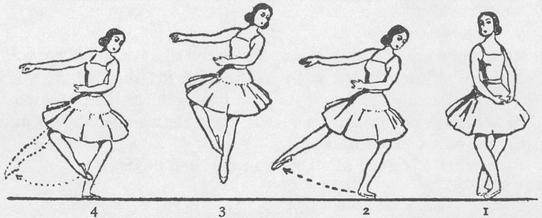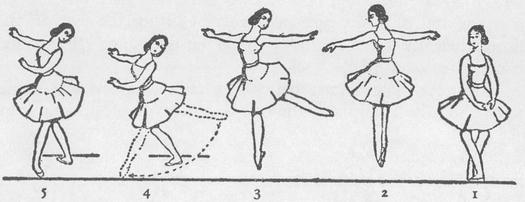Basic Principles of Classical Ballet (19 page)
Read Basic Principles of Classical Ballet Online
Authors: Agrippina Vaganova


81. Pas ballonné effacé (front)
In grand ballonné (at 90°), the foot may be bent to the knee, but in the small ballonné, the form is more correct if the foot is placed sur le cou-de-pied.
In the execution of ballonné, the body and the arms must not move during the jump, but remain in the pose, so that one should notice no strain or jerking.
24
PAS CHASSÉ
This pas is seldom used in the feminine dance, but more often in the masculine. Usually it is done several times in succession.
Stand in 5th position, right foot front, demi-plié, jump up, right leg opens into 2nd position at 45° (sissonne tombée to the right), but with a more passing movement than usual, the left leg is drawn in a gliding movement to the right one, the legs join during the jump in the air, very straight, in 5th position, with the toes extended and touching. At this moment the jump must be as high as possible. Immediately, the right leg opens again, and the movement continues.

82. Pas chassé
Pas chassé is done to all sides in required poses.
GLISSADE
It would seem that the very name of this step indicates the gliding characteristic of it. Yet we see that this movement is very seldom distinguished from other movements, and is lost on the stage. In the male dance especially it is difficult to see what is a glissade and what is just a simple running start for a leap.
This is bad for the dancer, because a properly executed glissade helps the leap, while a running start, with the legs thrown to this side and the other, tends to offset the whole body from the proper manner of doing the leap, and the leap loses its beauty and force.
Glissade may be done with or without a change of feet. At the beginning glissade is practised without change of feet. It is this form of the glissade that I shall analyse here.
Stand in 5th position, right foot front. Demi-plié, right foot with toe pointed glides along the floor to 2nd position and reaches it with the extended toe; immediately after that the body travels towards and onto the right leg without lifting the feet off the floor, then the left foot glides along the floor into 5th position back. Then demi-plié.
This is the basic characteristic of glissade: it begins and it ends with plié. The final plié is the one that helps the following leap, and for this reason glissade is the best preparation for leaps.

83. Pas glissade
Glissade may be done in different directions and in different poses. It is wrong to do glissade like jeté fermé, but it is also wrong to do it like creeping, without tearing oneself away from the floor.
If you do glissade as a preparatory movement to a big leap, open your arms to the sides at the same time as you open your legs to 2nd position, then close them again to the preparatory position. This will give force to the following leap.
PAS FAILLI
This movement is done on one count, all its changes are run together, and there is a certain characteristic fleeting air about it.
Stand in 5th position, right foot front. Demi-plié, jump up vertically, feet close together. During the jump turn body effacé back; lower yourself into demi-plié on right foot, open left one to 45° in effacé back, and immediately without a pause, move the extended toe of the left foot on the floor through the rust position forward into croisé, and then—demi-plié.
The proper character of failli can be achieved only with the correct accompaniment of the arms. There should be no underscored movement, the arms should move softly, as if spontaneously. At the beginning of the movement, the arms should be slightly thrown up, then the left arm moves forward together with the left leg, and at the same time the body inclines to the left.

84. Pas failli
One may finish it also differently, moving the arms into a pose, preparation à la pirouette, so that the final pose of failli could serve as a preparation from the 4th position for turns or for some other movement.
PAS EMBOÎTÉ
Stand in 5th position, right foot front. Demi-plié, jump up, right leg bent to 43°; fall on right foot in demi-plié, while in the air move the left leg forward, bending it, jump up again, move the right leg forward. Finish on left foot in demi-plié, the right leg forward and bent.
To do this movement correctly, the bent leg should move beyond the straight one during each change. Emboîté back is done the same way.
Emboîté can also be done high (grand emboîté), that is, at the level of the knee. The leg is thrown out higher and is bent less. On the stage it is very effective to do emboité in a series, beginning low with a very small one, and gradually throwing the leg up higher and higher, to a grand emboité.
EMBOÎTÉ EN TOURNANT
Stand in 5th position, right foot front. Demi-plié, jump to the side, flying to the right with the entire body and legs, simultaneously, while in the air move the left leg forward and bend it; lower yourself on right foot in demi-plié with the back to the audience, bending left leg in front of you to 45°, turn in the air with a jump, flying in the same direction and landing on left foot in demi-plié en face, bending right leg in front, and continue the same way.

85. Pas emboîté en tournant,
The arms should assist. At the beginning, the right arm is in 1st position, left one open in 2nd. Push off the floor, and during the jump throw the arms to the sides and during the stop with the back to the audience, move the left arm to the 1st position simultaneously with the left leg; at the next turn and jump, throw left arm to the side, and move right one forward together with right foot, etc.
PAS BALANCÉ
This is one of the simple pas allegro which is easily done even by children. In classical dancing it is often used in waltz tempo.
Stand in 5th position, right foot front. From demi-plié do a light jeté with the right foot to the side, and then draw left foot back (on count
one).
On count
two
change to the left foot on half toe, and on
three
lower yourself again on right foot in demi-plié, and raise the left one sur le cou-de-pied back.

86. Pas balancé
The next balancé will be to the left, i.e. jeté left, etc.
CABRIOLE
Cabrioleis done forward and backward, croisé, effacé, écarté, in arabesque, from 5th position, or from some preparatory pas such as a small sissonne tombée or coupé. The form of the cabriole itself does not change with the direction or preparatory pas, and therefore I shall describe here the most widely used: cabriole in effacé forward.
We begin to practice cabrioles fairly low, and all the following rules for cabriole at 90° apply also to the study of it at 45°.

87. Cabriole
As in all our examples we do a cabriole from the right foot. To do a cabriole from the right foot, begin with preparation croisé, left foot front; from demi-plié on the left foot, the right leg is thrust up to 90° in effacé forward, the left leg is drawn to the right one and hits it with the calf. The legs must be fully extended, the knees well straightened, toes forcefully pointed. The right leg must not be lowered to meet the hitting left one. Fall on the left foot in demi-plié, keeping the right leg in the pose that was ordered, in this example effacé forward.
